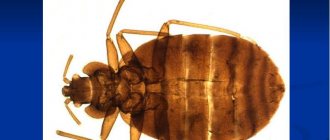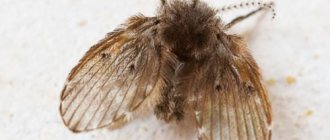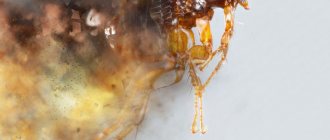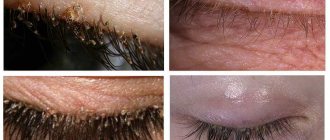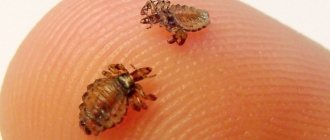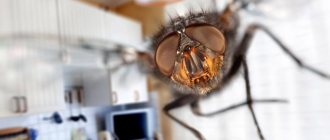Where do they come from
Diptera insects can enter a home in different ways:
- fly into an open door;
- into open windows;
- through the ventilation holes.
Why can they appear in one apartment, while in another they may not exist at all? Thanks to their excellent sense of smell, these parasites sense the specific aromas of decaying products from afar and fly towards this smell from all sides. Swarms of flies also flock to the aroma of freshly prepared food, therefore, their main habitat in the house is the kitchen.
Flies on food
Where do flies come from in apartments?
Another route for getting Diptera into both a house and an apartment can be called very romantic - with a bouquet of wildflowers. Since there is a whole species that feeds on the pollen of flowering plants. But instead of decorating the room, they cause a lot of trouble and jeopardize the cleanliness of the living space.
Even the name of the parasite, which buzzes and irritates the inhabitants of the premises, is symbolic “house fly”. And yet, in some apartments flies are a rare occurrence, while in others there are many of them and they behave like owners. The most common reason is lack of cleanliness and hygiene in the kitchen. Parasites are attracted
- Stale garbage;
- Remains of bread on the table;
- Unwashed dishes in the sink;
- Vase with spoiled fruit;
- Increased humidity and temperature in the room;
- Traces of dirt brought in from the street. Especially if the inhabitant of the apartment passed by a garbage dump.
If everything is clear with the warm period of the year, then the appearance of flies in winter is a big question.
Habitat
These parasites are very attracted to putrefactive organic waste - they exist thanks to food debris. If an infestation of flies has been recorded in your home, it means that sanitary and hygienic standards are not being observed in the home and this is a clear sign that the room needs to be thoroughly cleaned.
The main influx of pests occurs from May to September, when the air temperature rises above 12 degrees. Having woken up, they begin to actively reproduce; during this period, the parasite population increases to its maximum and rapidly increases.
There are a lot of flies near private property, this is due to the fact that cesspools and compost heaps are very attractive to insects - they lay their eggs there. There are even types of parasites that lay eggs in the soil of indoor plants. Then flies emerge from them and feed on these plants.
Let us immediately note that it is very difficult to fight flies on your own site. Winged insects are omnipresent and are always looking for where they can profit and begin to reproduce. They can fly in from anywhere: from neighbors or from other streets.
The main influx of flies occurs from May to September
These parasites also appear in apartments in mid-spring. Having settled in your home, the fly lays its eggs wherever possible: in trash cans, on any food products: meat, sausage, cheese, bread, candy and cookies. They are especially attracted to animal feces and rotten meat. Try to keep your apartment clean and to ensure that it does not create conditions for insects to breed: store food in airtight containers, put unnecessary items in the refrigerator.
Massive colonies of flies in an apartment mean that their breeding place is nearby. Parasites fly in on their own, but sometimes they can be brought into the house with clothes or with purchases made at the market. Having entered the home, they begin to spoil food, depositing their waste products on it. In this case, it is necessary to take measures to destroy them as quickly as possible for your safety.
Nutritional Features
This species is not blood-sucking, unlike its larger relatives - the gadfly and the dung fly, which does not prevent them from causing a lot of trouble and problems to the people in whose housing they live. Houseflies prefer organic food, obtaining it from manure, biological waste of animals and humans, and other decomposing substances. However, they do not disdain human food products, fructose and sucrose from plant fruits, and even flower nectar.
The housefly's mouthparts are not adapted to process solid food, so food enters its body in liquid form.
To do this, she uses a peculiar, forked proboscis with two channels, through which everything necessary is absorbed. Particularly tasty hard pieces of the fly are patiently dissolved with saliva.
The specificity of food preferences, along with mobility, makes them the main carriers of various intestinal infections and pathogenic bacteria that provoke the development of dangerous diseases in humans. And the speed of reproduction significantly complicates the fight against them, because in less than a month of its existence, the female is capable of laying up to 2000 eggs.
Fact:
In ancient times, the larvae's tendency to eat dead organic matter was used to heal festering wounds.
Where do flies come from in winter?
As a rule, these pests are active only in warm weather. As soon as the cold weather sets in, flies, and especially green parasites, begin to look for a secluded place for the winter. They are very attracted to our warm houses, which have enough small cracks and secluded areas. It is in these places that they spend the winter, and after it gets warmer outside, the insects begin to be active again.
In winter, flies cannot enter the house, but if you find them in your home, this means that they woke up earlier.
Where do flies come from in winter?
In the cold season, dipterous insects obviously cannot enter the room through the street - they simply will not survive in such conditions. This phenomenon is familiar to residents of the lower floors of apartments in multi-story buildings. The justification will be that the lower floors are located close to garbage cans and landfills. Another source is the close location to basement damp rooms, where the environment for parasites to live and reproduce is very favorable. If garbage chutes are still preserved in multi-storey buildings, this risk extends to all floors, right down to the last.
With private houses, things are even worse. An innumerable list of opportunities for oviposition and reproduction. Compost pits with fertilizer for all kinds of plants, a barn with livestock, an outdoor toilet and a cesspool - all these are comfortable “apartments” for parasites. The most interesting thing is that once a fly has entered the house, it has practically no chance of getting out. In the winter season, at sub-zero temperatures, windows are rarely opened, and if they are opened, it is for minimal ventilation, and most often the windows have a barrier in the form of a mosquito net. An interesting fact is that the insect has a feature in the structure of its eyes that does not allow it to distinguish a glass barrier.
Despite the fact that the insect causes a lot of unpleasant sensations, in folk superstitions there are some “pleasures” associated with the appearance of flies in the house, glass and other surfaces. But even taking this into account, there is no great desire for these buzzing creatures to live in houses. And no matter how much effort and effort is put in, it is very difficult to track or prevent the appearance of these insects. After all, everyone brings vegetables and fruits into the house, and it doesn’t matter whether they bring them from their garden or buy them at the market. Everyone has at least once left unwashed dishes in the sink overnight because they were tired. And the owner is trying to decorate her apartment with wildflowers. But it is worth keeping in mind that dirt, unsanitary conditions, a warm and humid environment are the main sources of prosperity and reproduction of flies. And it doesn’t depend so much on weather conditions.
Preventive measures
Do not forget that these winged insects are spreaders of various diseases:
- tuberculosis;
- helminthic infestation;
- intestinal infections;
- food poisoning;
- anthrax;
- brucellosis.
Even windows with mosquito nets and closed doors will not protect you from the invasion of hordes of flying insects. They can enter the house in other ways. How to get rid of this scourge?
Since the parasites are quite small, this allows them to easily penetrate any holes and cracks, including through ventilation shafts. Even the doors to the entrance must be closed constantly, since this is the easiest way for them to enter.
Important! The best preventive measure against the appearance of flies is regular cleaning of the room, and especially the kitchen. Do not leave leftover food, vegetables and fruits in accessible places, and also try to take out the trash in a timely manner.
The best preventative measure against pests is regular cleaning of the premises.
How to avoid flies in your apartment?
Protecting your home from flies is much easier than fighting insects already flying in it. Moreover, you don’t need to do anything special for this. The main thing is to maintain cleanliness and follow a few simple rules:
- in the warm season, install mosquito nets on the windows;
- Take out the trash every day, wash the trash can, and close it with a lid;
- immediately after eating, clear the table, throw away leftovers, clean up, etc.;
- do not leave dirty dishes in the sink;
- regularly do wet cleaning in the kitchen, wash the stove, sink;
- avoid dampness, make sure there are no leaks, water houseplants moderately, wring out sponges and rags thoroughly;
- If possible, store vegetables and fruits in the refrigerator, periodically sort through them, throw away those that begin to spoil;
- carefully inspect fruits, vegetables and herbs before purchasing so that there are no eggs laid on them;
- Seal the ventilation holes in the house with fine mesh.
These recommendations will help you avoid many problems that may arise if flies appear and breed in your house.
The appearance of flies in the house in the fall: causes and solution to the problem
Good afternoon, my reader. The question of why flies appear in the house occupies many people. In the fall, this problem affects both people living in the country and those who are in the city. The main reason for this phenomenon is the location near the home of places that attract insects and are suitable for their livelihoods. Such places include:
Flies in the house. The illustration for the article is used under the standard license ©ofazende.com
- Compost heaps and cesspools are a favorite habitat for flies. If such insect magnets are not located on your property, but on a neighboring one, the threat of flies in the house is still high.
- A nearby trash container. When the garbage can is not tidied up and there is garbage on the ground, this attracts flies even more.
- Smells of food in the house, crumbs left on the table, uncovered and uncleaned leftovers. To eliminate this factor, always seal food tightly and put it away immediately after eating.
- Infrequent trash removal. If you rarely throw out trash, there is a risk that the smell of spoiled food stored in the bin will attract pesky insects.
Summer is a period of active breeding of flies, and all grown flies in the fall strive to find a warm place for wintering.
Windows, doors, cracks in walls and ceilings are all potential entry points for insects. They occupy openings in order to wait out the cold and fly away from there in the spring, so when the temperature rises they begin to actively move around the house.
It is customary to distinguish 3 groups of methods for controlling flies:
- folk;
- modern;
- chemical.
Folk remedies for pest control
The simplest and most accessible, folk methods of eliminating flies in the house are the most popular. This group includes sticky tape, special plants, and various poisons.
Flies in the house. The illustration for the article is used under the standard license ©ofazende.com
Duct tape
This method looks unpleasant and has no aesthetic function, but is quite popular among those faced with fly infestations. This tape is sold at any hardware store and is inexpensive. And the disadvantages of the trap include:
- the disgusting sight of flies stuck to the bait: you should not look at the tape before eating;
- Clothes or hair may stick to the trap;
- For large rooms one tape is not enough; you will need to buy several.
Vacuum cleaner against flies
A more radical and effective method is a vacuum cleaner to catch insects. With this tool you need to walk along windows, window sills, corners, this way the device will absorb flies. The disadvantages of an anti-pest vacuum cleaner are:
- the presence of places inaccessible to tools that he cannot reach;
- Not all owners of summer cottages have a vacuum cleaner in their arsenal, and bringing the device from the city is not the best option.
Natural poisons
Foods that are tasty and healthy for humans can be poisonous to flies. For example, seasonings or garlic.
- Black pepper. By mixing ground fruit with honey or jam, you will get a mixture that is poisonous to insects.
- Carnation. This spice needs to be spread out in places where flies accumulate; you can first stick it into the orange zest.
- Chopped garlic. This product, placed in saucers, must be placed in places where insects live. You are guaranteed a destructive effect on pests.
Modern fly control options include trap lamps, insecticidal lamps and electric fly swatters. Electric fumigators release odors that flies cannot tolerate.
